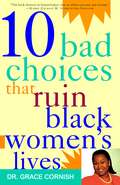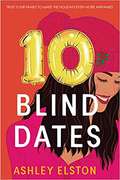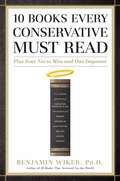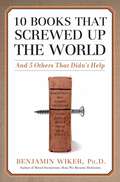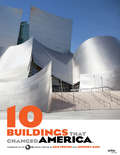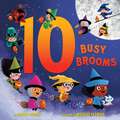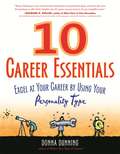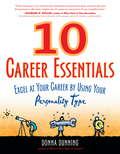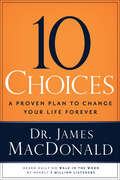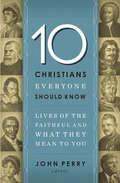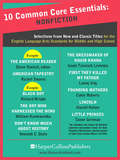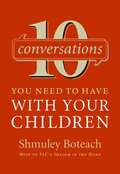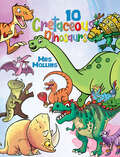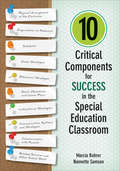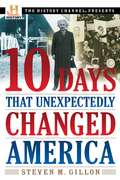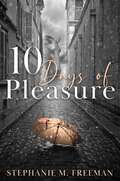- Table View
- List View
10 Actual, Official LSAT Preptests (Volume #6)
by Law School Admission CouncilFor pure practice at an unbelievable price, you can't beat the 10 Actual series. Each book includes: 10 previously administered LSATs, an answer key for each test, a writing sample for each test,score-conversion tables, and sample Comparative Reading questions and explanations.
10 Answers for Atheists: How to Have an Intelligent Discussion About the Existence of God
by Alex McfarlandWith notable nonbelievers such as Richard Dawkins, Sam Harris and Christopher Hitchens featured prominently in the media, it is no surprise that many Christians wonder how best to answer the growing number of atheist arguments they encounter every day. 10 Answers for Atheists is a one-of-a-kind resource from respected Christian apologist Alex McFarland that looks closely at the philosophical assumptions at the root of atheism and agnosticism and exposes the logical, historical and conceptual fallacies that perpetuate unbelief. Readers will find easy to understand charts and clear explanations of key beliefs, as well as trustworthy, biblical answers to the honest questions posed by atheists and agnostics. Every reader, no matter where he or she falls on the spectrum of belief, will hear a call to thoughtful engagement with the historic Christian faith.
10 Bad Choices That Ruin Black Women's Lives
by Grace CornishIn 10 Bad Choices That Ruin Black Women's Lives, relationship expert Dr. Grace Cornish writes a lively, practical, provocative guide for black women everywhere who want to shed the duds and find the studs who will treat them with respect.According to Dr. Cornish, six out of every ten black women are either in bad relationships, share a man, or are celibate. The problem is not the women themselves but the bad choices they keep making. In her frank and refreshing new book, Dr. Cornish speaks to unique aspects of the African American female psyche by targeting ten of the most common and foolish choices black women make in their lives regarding men, and how they can correct these problems, including:Sisters Dissin' SistersNo Money, No HoneyExchanging "Sexual Dealings" for Loving FeelingsLoving the "Married Bachelor" Emotional Dependency Plus Unplanned Pregnancy. . . and much more.Relying on case studies, interviews, and letters she has received, Dr. Cornish gets to the heart of the matter by illuminating why black women, no matter how smart, savvy, and successful, continue to lose at the dating game, and how they can face, erase, and replace the problems that have kept them from finding true love.Why are so many black women alone or in bad relationships?Why do sisters unconsciously use weight, fear, finance, status, skin color, and other barriers to keep themselves from getting the love they want?Why do black women think that there are no eligible black men left--that the good ones are married, dead, or not yet born, and the rest are gay, bisexual, or interested only in white women?From the Hardcover edition.
10 Best College Majors for Your Personality
by Laurence ShatkinBy choosing a major that fits their personality, college students may improve their career certainty, graduation rates, and even school involvement and satisfaction, according to research. With this best-selling book, students discover their personality type and the 10 best majors that relate to it.
10 Blind Dates
by Ashley ElstonSophie wants one thing for Christmas―a little freedom from her overprotective parents. So when they decide to spend Christmas in South Louisiana with her very pregnant older sister, Sophie is looking forward to some much needed private (read: make-out) time with her long-term boyfriend, Griffin. Except it turns out that Griffin wants a little freedom from their relationship. Heartbroken, Sophie flees to her grandparents’ house, where the rest of her boisterous extended family is gathered for the holiday. That’s when her nonna devises a (not so) brilliant plan: Over the next ten days, Sophie will be set up on ten different blind dates by different family members. Like her sweet cousin Sara, who sets her up with a hot guy at an exclusive underground party. Or her crazy aunt Patrice, who signs Sophie up for a lead role in a living nativity. With a boy who barely reaches her shoulder. And a screaming baby. When Griffin turns up unexpectedly and begs for a second chance, Sophie feels more confused than ever. Because maybe, just maybe, she’s started to have feelings for someone else . . . Someone who is definitely not available. This is going to be the worst Christmas break ever . . . or is it?
10 Books Every Conservative Must Read: Plus Four Not to Miss and One Impostor
by Benjamin WikerFollowing up his 10 Books That Screwed Up the World, author Benjamin Wiker brings you 10 Books Every Conservative Must Read: Plus Four Not to Miss and One Impostor. Offering a guide to some of the most important literary works of our time, Wiker turns his discerning eye from the great texts that have done so much damage to Western Civilization to the great texts that could help rebuild it. 10 Books Every Conservative Must Read features a range of works from classics such as Democracy in America and The Federalist and Anti-Federalist Papers, to more "pop" classics like Sense and Sensibility and The Tempest. Through these works, Wiker reveals some of the most important lessons for our time as well as the true meaning of conservatism. Written with an educational purpose and witty tone, this is a must-read for conservatives, Republicans, and booklovers everywhere!
10 Books that Screwed Up the World: And 5 Others That Didn't Help
by Benjamin WikerYou've heard of the "Great Books"?These are their evil opposites. From Machiavelli's The Prince to Karl Marx's The Communist Manifesto to Alfred Kinsey's Sexual Behavior in the Human Male, these "influential" books have led to war, genocide, totalitarian oppression, family breakdown, and disastrous social experiments. And yet these authors' bad ideas are still popular and pervasive--in fact, they might influence your own thinking without your realizing it. Here with the antidote is Professor Benjamin Wiker. In his scintillating new book, 10 Books That Screwed Up the World (And 5 Others That Didn't Help), he seizes each of these evil books by its malignant heart and exposes it to the light of day. In this witty, learned, and provocative exposé, you'll learn:* Why Machiavelli's The Prince was the inspiration for a long list of tyrannies (Stalin had it on his nightstand)* How Descartes' Discourse on Method "proved" God's existence only by making Him a creation of our own ego* How Hobbes' Leviathan led to the belief that we have a "right" to whatever we want* Why Marx and Engels's Communist Manifesto could win the award for the most malicious book ever written* How Darwin's The Descent of Man proves he intended "survival of the fittest" to be applied to human society* How Nietzsche's Beyond Good and Evil issued the call for a world ruled solely by the "will to power"* How Hitler's Mein Kampf was a kind of "spiritualized Darwinism" that accounts for his genocidal anti-Semitism* How the pansexual paradise described in Margaret Mead's Coming of Age in Samoa turned out to be a creation of her own sexual confusions and aspirations* Why Alfred Kinsey's Sexual Behavior in the Human Male was simply autobiography masquerading as scienceWitty, shocking, and instructive, 10 Books That Screwed Up the World offers a quick education on the worst ideas in human history--and how we can avoid them in the future.
10 Buildings That Changed America
by Dan Protess Geoffrey Baer10 Buildings that Changed America tells the stories of ten influential works of architecture, the people who imagined them, and the way these landmarks ushered in innovative cultural shifts throughout our society. The book takes readers on a journey across the country and inside these groundbreaking works of art and engineering. The buildings featured are remarkable not only for aesthetic and structural reasons, but also because their creators instilled in them a sense of purpose and personality that became reflected in an overarching sense the American identity.Edited by the staff of WTTW, the Chicago PBS affiliate that is the most-watched public television station in the country, 10 Buildings will be released alongside the national broadcast of an hour-long special by the same name. This television event will be promoted over digital media, on-ground events, and educational initiatives in schools, and the book will be a significant component to all of these elements.10 Buildings retells the shocking, funny, and even sad stories of how these buildings came to be. It offers a peek inside the imaginations of ten daring architects who set out to change the way we live, work, and play. From American architectural stalwarts like Louis Sullivan and Frank Lloyd Wright, to modern revolutionaries like Frank Gehry and Robert Venturi, this book examines the most prominent buildings designed by the most noteworthy architects of our time.Also profiled are Americans less noted for their architectural acumen, but no less significant for their contributions to the field. Thomas Jefferson, a self-taught architect, is profiled for designing the iconic Virginia State Capitol. Taking its inspiration from ancient Rome, America's first major public building forged a philosophical link between America and the world's earliest democracies. Similarly, Henry Ford employed Albert Kahn to design a state-of-the-art, innovative factory for Ford's groundbreaking assembly line. Reinforced concrete supported massive, open rooms without any interior dividing walls, which yields the uninterrupted space that was essential for Ford's sprawling continuous production setups. What's more, Kahn considered the needs of workers by including astonishingly modern large windows and louvers for fresh air.The design of each of these ten buildings was completely monumental and prodigious in its time because of the architect's stylistic or functional innovations. Each was also highly influential, inspiring a generation or more of architects, who in turn made a lasting impact on the American landscape. We see the legacy of architects like Mies van der Rohe or H.H. Richardson all around us: in the homes where we live, the offices where we work, our public buildings, and our houses of worship. All have been shaped in one way or another by a handful of imaginative, audacious, and sometimes even arrogant individuals throughout history whose bold ideas have been copied far and wide. 10 Buildings is the ideal collection to detail the flashes of inspiration from these architects who dared to strike out on their own and design radical new types of buildings that permanently altered our environmental and cultural landscape.
10 Busy Brooms
by Carole GerberCelebrate Halloween with this fun and festive counting book, perfect for fans of Room on the Broom!Young readers will want to fly the night sky with the ten little witches in this bright and adventurous Halloween story. Whether zooming past rattling skeletons, buzzing by pie-stealing mummies, or soaring over a werewolf with bad breath, this exciting group of witches and their high-flying Halloween adventures will have readers cheering! Plus, play a game of I Spy and find the cat and owl on every page!"An enjoyable celebration of witchy sisterhood."—Publisher's Weekly"Bright and cheerful."—School Library Journal
10 Career Essentials: Excel at Your Career by Using Your Personality Type
by Donna DunningFocusing on day-to-day behaviors, as well as practical tips and strategies, author Donna Dunning shows readers how to make the most of the 80,000 hours the average person spends at work. Dunning provides key self-assessment tools and tips, allowing each individual to improve and implement their career strategy based on their personality type.
10 Career Essentials: Excel at Your Career by Using Your Personality Type
by Donna DunningThere are many books to help you choose a career, but few to help you excel in the workplace once you are working. Over the course of a lifetime, people can spend 80,000 hours on the job. With this much time invested, author Donna Dunning asserts that your career should be interesting, motivating and rewarding. And in our competitive, rapidly changing society, you need to know how to be effective and competent at work or you may find yourself unemployed or passed over for promotion. Focusing on day-to-day behaviour and providing practical tips and strategies, 10 Career Essentials becomes your personal career coach by showing you how to work effectively, get recognition and steer your career in the direction you want to go. The ideas such as optimizing your outlook, exceeding expectation and thriving in uncertainty may sound simple, but applying them takes skill and practice. 10 Career Essentials provides the key self-assessment tools and tips to stimulate learning and improve your ability to implement your personal career strategy to its fullest.
10 Choices: A Proven Plan to Change Your Life Forever
by James MacDonaldMany people see their lives playing out like a movie they cannot control. They have come to feel like spectators watching a story unfold, unable to stop the stampeding consequences. They feel the die is cast, and nothing they do can alter the outcome. James MacDonald believes that is a lie. In 10 Choices he says, while people are where they are in life because of the choices they've made, they don't have to stay there. This book is about getting beyond self-help and blame shifting and changing at the deepest and most profound level...the will.A person's will is what he uses to choose and act. This book helps readers to discover the heights to which their wills, truly surrendered to God, can actually soar and the "10 choices" that can take them there. This impactful book will prompt readers to make 10 Choices that are sure to change their lives forever.
10 Christians Everyone Should Know: Lives of the Faithful and What They Mean to You
by John PerryJane Austen, Sergeant York, Saint Patrick—What did they have in common?Two thousand years and still going strong: that’s the story of Christianity. And while the Christian martyrs and saints and orators may have gotten more press, the fact is the faith has been carried through history in the hearts and deeds of believers who—though beloved to us now—were simply living ordinary lives of devotion.“It would be almost impossible to imagine ten people more different from each other than these,” editor John Perry says. “This [is] the first truth of Christian living: anybody, anywhere can be a champion of the faith, an example and inspiration to all who follow.”There’s no dry biography here, though. Each story teems with fresh insight. D. L. Moody did some of his most powerful evangelizing by befriending ragged street children in Chicago. William F. Buckley never delivered a sermon, yet a Christian worldview informed his erudite, witty, output in print and broadcasting. To compose her poems, Anne Bradstreet had to understand science, history, the Bible, and literature, not to mention the political scene in both Massachusetts and England. You’ll look with new eyes, also, on the lives of George Washington Carver, Jane Austen, Galileo, Johann Sebastian Bach, Sergeant York, John Bunyan, and Saint Patrick. You might think you know their stories . . . but you don’t. Not yet.For lovers of biography, for homeschool or study groups, for anyone seeking encouragement in the Christian walk, 10 Christians Everyone Should Know is a valuable resource.
10 Common Core Essentials: Selections from New and Classic Books for the English Language Arts Standards for Middle and High School
by Harper AcademicThe excerpts featured in this free sampler come from some of our most popular nonfiction books for middle and high school classrooms—making them ideal choices to meet the new Common Core Standards for the English Language Arts. From the primary documents of The American Reader to The Boy Who Harnessed the Wind—the story of young man from an impoverished African village who built a windmill to bring life-changing electricity to his community—these books will take students across time periods and around the world. They'll grapple with complex ideas and meet people from the past and present who will inspire them. Along the way, your students will come to understand the components of critical thinking and good writing—and why they matter.
10 Conversations You Need to Have with Your Children
by Shmuley BoteachWhy do I have to repeat everything? Why does every conversation end in an argument? Communicating with our children. Conversing. Connecting. When did it become so difficult? And how do we begin to change it for the better? This book was designed to help parents answer these important questions, and it is based on two fundamental ideas: The first is that there are no bad children, and no deliberately bad parents -- but that sometimes, despite the best of intentions on both sides, there can be bad relationships between parents and children. The second is that, as parents, we must do everything we can to save those relationships, to reach out and really communicate with our children, because it is only through talking to them that we can create an environment for inspiration and change. In this compelling book, Shmuley Boteach, passionate social commentator and outspoken relationship guru, walks you through the critical conversations, including: cherishing childhood; developing intellectual curiosity; knowing who you are and what you want to become; learning to forgive; realizing the importance of family and tradition; being fearless and courageous. As a father of eight, Rabbi Shmuley speaks from a wealth of experience. He has written a book for parents of children of all ages, from toddlers, who are just beginning to become aware of the world around them, to adolescents, who must learn to navigate all sorts of tricky social and academic pressures. 10 Conversations will help you stay connected to your children so that they develop the kind of strong moral character that leads to rich, meaningful lives.
10 Count Trivia
by Dean MillerWill you be counted out? Can you pin down the answer before that fateful 10 count sounds? Or will you be left out? There is only one way to discover just who is the champ, who really knows sports entertainment. Ten little questions to prove if you really know everything about the events and championships that have raised the rafters in arenas across the globe and carved a place in the history of WWE for the Superstars who dared to step into the ring. We dare you to step up. Take the challenge. It might not be a Texas Death match, but you never know.
10 Cretaceous Dinosaurs
by Mrs MollinsJoin the adventure with 10 Cretaceous Dinosaurs, a delightful countdown poem from ten to none. Each page introduces a new dinosaur with fun facts and vibrant illustrations. Perfect for young readers eager to learn and have fun with prehistoric creatures!
10 Critical Components for Success in the Special Education Classroom
by Marcia Rohrer Nannette SamsonYour blueprint for building structure, consistency, and accountability year-round! This must-have guide provides special education teachers with a solid, workable action plan to manage the classroom and ensure student success. Learn instructional strategies to: Support all students with special needs, including those with more severe disabilities Organize your classroom, materials, and staff and student schedules Plan and assess standards-based lessons, annual IEP's, behavioral interventions, and more Foster parent communication and staff collaboration Packed with real-world examples, free tools to use and share, a list of resources and a helpful glossary, this dynamic resource will inspire you, develop your teacher toolbox, and ensure your students are on the path to achievement!
10 Critical Components for Success in the Special Education Classroom: Gargiulo: Special Education In A Contemporary Society 5e + Rohrer: 10 Critical Components For Success In The Special Education Classroom
by Marcia W. Rohrer Nannette M. SamsonYour blueprint for building structure, consistency, and accountability year-round! Often teachers of all experience levels struggle to effectively manage special education classrooms. In this must-have guide, Rohrer and Sampson provide a solid, workable action plan to ensure measurable success for even your most challenging student. Discover a variety of research-based instructional strategies to: Support all students, including those with autism and severe learning disabilities Organize your classroom, materials, and staff and student schedules for optimal teaching and learning Execute well-planned standards-based lessons, annual IEP’s, PLAALP’s, behavioral interventions, and visual supports Develop communication and social skills within a language-rich environment Foster parent communication and staff collaboration Packed with real-world examples, free tools to use and share, a list of resources and a helpful glossary, this dynamic resource will inspire you, develop your teacher toolbox, and ensure your students are on the path to achievement! "10 Critical Components for Success in the Special Education Classroom offers practical and easy-to-use ideas for organizing your physical classroom space, materials, student and staff schedules. Readers will also receive well thought out strategies that will definitely aid in the ultimate end result—student success!" —Avis Canty, Special Education Teacher Tanglewood Middle School, Greenville, SC "The path to success for students with autism and intellectual disabilities starts here, when their teachers implement the essential critical components outlined in this book." —Renee Bernhardt, Learning Support for Special Education and RTI Cherokee County School District, Canton, GA
10 Critical Components for Success in the Special Education Classroom: Gargiulo: Special Education In A Contemporary Society 5e + Rohrer: 10 Critical Components For Success In The Special Education Classroom
by Marcia W. Rohrer Nannette M. SamsonYour blueprint for building structure, consistency, and accountability year-round! Often teachers of all experience levels struggle to effectively manage special education classrooms. In this must-have guide, Rohrer and Sampson provide a solid, workable action plan to ensure measurable success for even your most challenging student. Discover a variety of research-based instructional strategies to: Support all students, including those with autism and severe learning disabilities Organize your classroom, materials, and staff and student schedules for optimal teaching and learning Execute well-planned standards-based lessons, annual IEP’s, PLAALP’s, behavioral interventions, and visual supports Develop communication and social skills within a language-rich environment Foster parent communication and staff collaboration Packed with real-world examples, free tools to use and share, a list of resources and a helpful glossary, this dynamic resource will inspire you, develop your teacher toolbox, and ensure your students are on the path to achievement! "10 Critical Components for Success in the Special Education Classroom offers practical and easy-to-use ideas for organizing your physical classroom space, materials, student and staff schedules. Readers will also receive well thought out strategies that will definitely aid in the ultimate end result—student success!" —Avis Canty, Special Education Teacher Tanglewood Middle School, Greenville, SC "The path to success for students with autism and intellectual disabilities starts here, when their teachers implement the essential critical components outlined in this book." —Renee Bernhardt, Learning Support for Special Education and RTI Cherokee County School District, Canton, GA
10 Crochet Flowers: Crochet Patterns for Stylish Flowers
by Claire CromptonCreate beautiful flowers with these 10 crochet patterns. Add them to garments and interior items, or use them to make jewellery. Featuring a rose and rose bud, sunflower, daisy, pansy, hellebore and other pretty flower designs, you're sure to find a pattern you love!
10 Dates to Your Soulmate: A Celebrity Matchmaker's Guide from First Swipe to Forever
by Christie KederianSay goodbye to ghosting, gaslighting, games, and guilt from past mistakes in dating relationships. 10 Dates to Your Soulmate uncovers how you can get from a first date to knowing someone is your soulmate in 10 dates or less.Finding forever love doesn't have to feel impossible. 10 Dates to Your Soulmate is a road map that gets you past first dates, providing practical dating tips and strategies, as well as insightful questions and observations to help you not only identify a good partner, but also recognize your own roadblocks to love (and move past them once and for all).In this book, relationship therapist and celebrity matchmaker Dr. Christie Kederian presents a research-backed and proven step-by-step process that will help you:Get clear about who you are, what you're looking for, and your expectations for a relationshipEvaluate your past and understand how previous relationships may be holding you back from creating love with someone newExplore attachment wounds, fears, and vulnerabilities that often come to the surface early in a relationshipIdentify common self-protective strategies that are no longer helping you and distinguish trauma responses from true red flagsAnd, after 10 dates, help you understand how to approach the future of the relationship with confidence and clarity Learning about someone's character is a lifetime endeavor, but in knowing how to ask the right questions and show up authentically, you will more quickly--and less painfully--grow a deeper relationship with your date and with yourself.
10 Days That Unexpectedly Changed America
by Steven M. GillonA companion book to The History Channel's special series of ten one-hour documentaries, 10 Days That Unexpectedly Changed America pinpoints pivotal days that transformed our nation. For the series and the book, The History Channel challenged a panel of leading historians, including author Steven M. Gillon, to come up with some less well-known but historically significant events that triggered change in America. Together, the days they chose tell a story about the great democratic ideals upon which our country was built. It is a snapshot of our country as we were, are, and will be.
10 Days of Pleasure (Days of Pleasure Series #1)
by Stephanie M. FreemanSome relationships are made in the storm. Real love survives them. Basketball star Dallas Avery has the world in the palm of his hand and a lifetime of happiness or despair within his grasp. For accomplished businesswoman, Alicia Mitchell, love is a double-edged sword wrought with happiness and pain. Business calls the soulmates to Scotland but a new, more treacherous storm is brewing back home. Can their love weather this latest test, or will a crueler fate prevail?ABOUT THE DAYS OF PLEASURE SERIESEach Pleasures book is a standalone, NO cliffhangersUSA TODAY, and National Bestselling Authors take you on amazing journey with NBA Basketball Star, Dallas Avery, and Alicia Mitchell, a woman who is as mysterious as she is beautiful.Follow this unlikely couple as they travel to exotic places such as Paris, Durabia, Caribbean, Scotland and many others. Each story embroils them in a new set of challenges and adventure as they navigate their way to love.Book 1–10 Days of Pleasure by Stephanie M. FreemanBook 2–20 Days of Pleasure by J. L. CampbellBook 3–30 Days of Pleasure by Sierra KayBook 4–40 Days of Pleasure by Martha Kennerson and Stephanie M. FreemanBook 5–50 Days of Pleasure by Anita L. Roseboro and Michelle D. RayfordBook 6–60 Days of Pleasure by VanessaBook 7–70 Days of Pleasure by Christine PaulsBook 8–80 Days of Pleasure by Aiken PonderBook 9–90 Days of Pleasure by Marie L. McKenzie and Naleighna KaiBook 10—Open Door Marriage by Naleighna Kai


